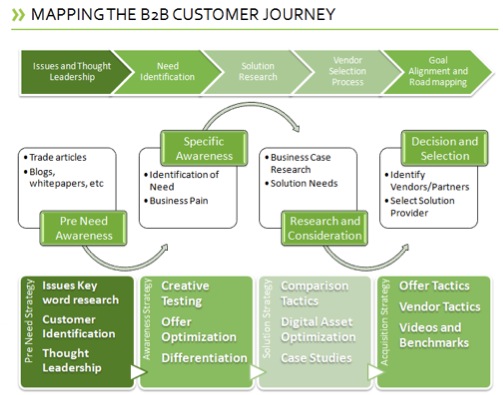To maximize online lead generation campaigns, B2B marketers need to focus on the multifaceted customer they serve. Design campaigns to meet their needs across the entire decision cycle and business buying process to achieve the optimal ROI from their program.
The Many Faces Of The B2B Customer
In the realm of the B2B marketer, one of the key challenges we face is the alignment of marketing efforts that meet complex customer needs. This can be found in all stages of the lifecycle from awareness and thought leadership, lead origination and generation, and the client engagement and business development.
It is a specifically a challenge in B2B to align the touch points of potential customers due to their varying needs at different stages and the many verticals being serviced.
What many B2B marketers have trouble with is properly identifying the customer journey and generating the most compelling experience to capture customers through their marketing mix. As a result, sales ready lead generation becomes the sole bellwether of effective B2B marketing efforts, leaving a wealth of additional opportunity on the table.
In a recent Forrester article Bigger B2B Marketing Budgets Come With Great Expectations, it is stated that product marketing (at 21.3%) and lead origination (at 15.7%) are the largest investments in the overall B2B marketing budget in 2011.
While every media mix is unique, in the B2B environment particularly, there is opportunity to extend brand engagement and ultimately generate more leads long term through looking at the entire B2B customer lifecycle.
The Light At The ‘Beginning’ Of The Funnel
Fortunately, there is good news for B2B marketers trying to tie together their efforts to capture their many target audiences. Given the ways we can now look at behavior through effective data capture in tracking and analytics, we are now able to spotlight actions and draw conclusions to inform effective strategies.
One of the key ways to do this is through the alignment of digital media campaigns that map to keyword signals from buyers across the lifecycle.
5 Steps To Construct Customer Driven B2B Lead Generation
In order to connect customers to the right experience in a B2B context, there are five steps to engineering the experience. In essence, identifying intent and need becomes the crux to help guide us as marketers and extend value to our buyers by enabling interaction no matter the stage.
From the start however, we need to begin by knowing what it is our customers are seeking and why.

1. Research Customer Behaviors
The first step is to thoroughly understand the ways in which your customers arrive at the decision to go to the market, and how they go about finding a solution to their needs. Most B2B customers’ begin the process with the identification of a challenge or issue that needs resolved.
As such, they will often go to the search engines or trade sites and search for issues and similar challenges. Identifying these keywords and the categorical interests around them provides the first stage to customer behavior. From this, you can identify related topics and content that provides the answers and serves as a bedrock of insight to inform your program.
2. Identify B2B Customer Journey Through Keyword Patterns
The ways that people find information is varied, however there are distinct patterns we all exhibit. For example, search is a known entry point into online content consumption. A B2B buyer will often go to a search engine to begin the process of identifying answers to the questions surrounding their needs.
According to one techtarget.com study1, at the beginning stages of researching a need, B2B buyers are more likely to use three-word keywords versus four-word phrases that are prevalent in later stages.
This kind of insight can allow the search program to identify what stage of the sales cycle a potential buyer is in to serve a relevant ad copy creative and relevant content. When we spotlight the funnel, we can observe behavior and test campaigns based on intent.
3. Identify Content Assets
To match the intent of the B2B query, the marketing campaign needs to identify existing content that can be leveraged immediately, i.e., webcasts, white papers, videos, case studies, etc.
Additionally, this is an opportunity to take an appraisal of where new content needs to be generated. From there, developing a content plan based on the customer journeys becomes a tangible case for the campaign.
A custom content plan can then be formulated to meet the needs of the buyer, and to effectively capture the demand of the stage.
4. Prioritize Messaging Plan
After the customer research and behaviors are identified, the next step is to prioritize marketing and business needs based on seasonality, relevance, and business efficacy. With an emphasis on the specific needs of the customer and stage, a benefit/effort map can be constructed with the customer in mind.
Through effective messaging and offer optimization, the B2B campaign is able to plan and test messaging that produces results.
5. Create An Integrated Media Project Plan
The final stage in the B2B customer driven plan is to create the media plan based on where the various audiences are online. Utilizing the research from the planning stage and adding in campaign planning, targeting and media mix modeling, a B2B campaign then must take into account where to place media budget to achieve the branding, acquisition and retention goals.
While a B2B campaign is often concerned only with the outcome of leads generated, it is by implementing a customer driven framework that a campaign is able to most effectively and efficiently capture demand across the entire lifecycle.
When a campaign is driven by customer needs and tied together by the performance data that online campaigns provide, a B2B budget is maximized for optimal ROI.
Related Reading:
*The Google/TechTarget Research Project: How IT Buyers Search Online During the Purchase Process
Opinions expressed in the article are those of the guest author and not necessarily Search Engine Land.
Related Topics: Strictly Business

No comments:
Post a Comment